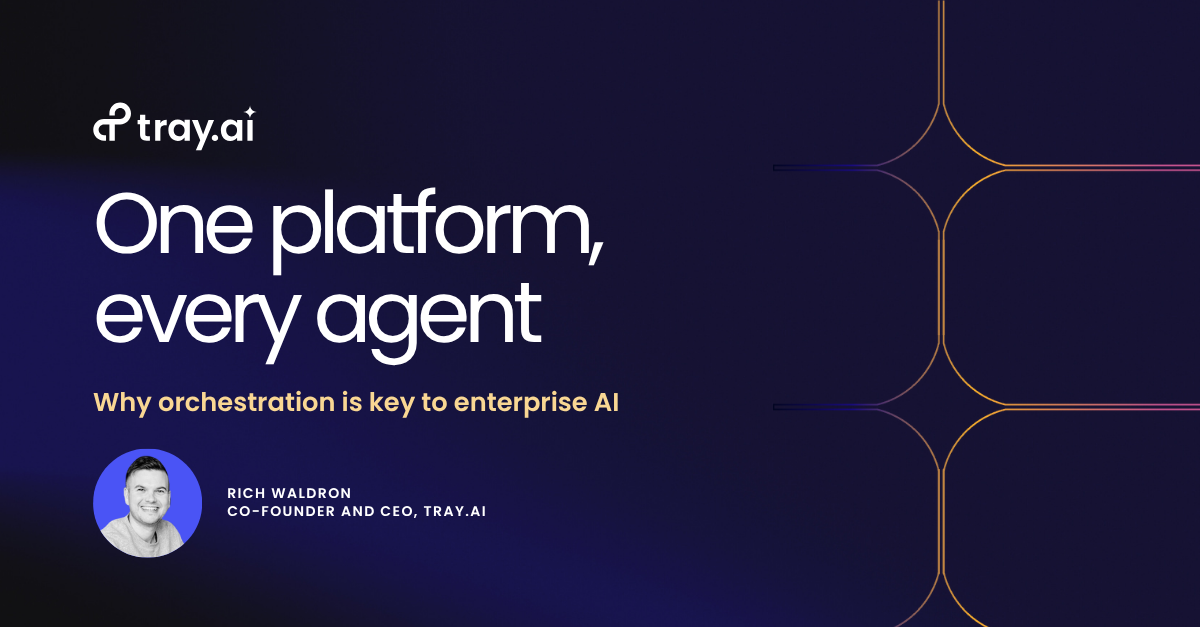Why orchestration is key to enterprise AI


Rich Waldron
CEO
AI agents are everywhere, but without orchestration, they create chaos, not value. Learn why IT leaders are turning to unified platforms to govern, scale, and deliver agents across the enterprise.
This article was originally published by Rich Waldron, Tray.ai co-founder and CEO, on LinkedIn.
Everyone’s talking about AI agents right now. They’re showing up in slide decks, embedded in SaaS tools, featured in every vendor pitch. They’re automating IT tickets, improving customer support, crunching ops data. But as often as they add productivity gains, they also add complexity.And that’s the real story I’m hearing from CIOs and IT leaders every week. Everyone wants the benefits. But most are heading toward agent chaos, not agent success.And what does success with AI agents even look like? While it’s still early days, I am certain that success is not about how many agents you can have. It’s about how effectively you can orchestrate them. For that, you need one platform that supports every team, every use case, and every agent.
Orchestrating agents at scale starts with unified delivery
Real AI agents do more than automate tasks. They make decisions, execute actions, and touch critical systems. But when every team builds agents in isolation, it doesn’t take long for things to break down. You get scattered embeddings, conflicting workflows, and maybe worst of all, no governance.It’s the same mess we saw in the early days of SaaS. Innovation raced ahead of infrastructure and enterprises spent years untangling it.The stakes are even higher now. A poorly governed agent can create significant overhead. It can also erode trust. That’s why I believe orchestration isn’t optional. You need one platform that unifies how agents are built, governed, and maintained across your enterprise.
Give every team a way in without giving up control
Agents are being used everywhere. IT, Ops, RevOps, Dev. Though some teams start with templates and others write code from scratch, they all need one thing: flexibility without silos.A unified platform supports both ends of that spectrum: no-code simplicity for process owners, full-code control for engineers. That way, agents are built on the same foundation with the same observability and the same guardrails.For IT leaders worried about agent chaos, it’s how you give every builder a way in without giving up control.
Connect your data before you connect your agents
Most enterprises aren’t blocked by a lack of agent ideas. They’re blocked by data. In a recent survey we conducted, 80% said data challenges are holding them back. And 86% said their infrastructure isn’t ready to scale agents.That’s the real gap. And it’s also why a unified platform matters. You’re not stitching together point tools or manually building pipelines. You’re integrating data, orchestrating execution, and applying policy in one place.It’s why leaders like Yext’s Tulasi Donthireddy say a unified platform has helped them move “beyond basic integrations and into true hyperautomation.” When everything’s connected, agents stop being a science project and start delivering real value.
The industry is paying attention
This isn’t just my take. It’s where the market is going.Tray.ai was named a Visionary in the 2025 Gartner® Magic Quadrant™ for iPaaS for the second year in a row. Then in their Critical Capabilities report, we earned the highest score for AI Implementation Support, highlighting the real-world agent work we’re enabling today.We were also recognized as a Leader in the 2025 Nucleus Research iPaaS Technology Value Matrix, thanks to advancements in our Merlin Agent Builder, which customers use to build and govern AI agents at scale.I believe these recognitions validate something the market has been saying for months: enterprises need orchestration. They need composability. They need a platform strategy for agent deployment.
The case for unifying AI now
There’s no denying that AI agents are here, but most teams are still stuck in the early innings. They’re testing pilots, running proofs of concept, and dealing with sprawl.If you want agents to succeed, they can’t live in silos. They need to operate as part of a larger system. One platform. Every agent. Every outcome.That’s how you go from experimentation to execution without compromising control.